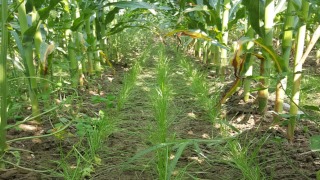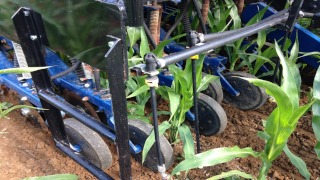By Eric Hamilton
Fields of amber grain may be the poetic image of American farmland. And it’s true that the U.S. grows plenty of wheat. But fields of yellow grain – corn – may be more accurate.

American farmers harvest nearly five times more corn than wheat. But this productive, useful crop requires fertilizer to reach its maximum potential, and is often not able to take up all the fertilizer it’s given. Excess nitrogen, in particular, can flow away from farms and damage waterways. That lost nitrogen can’t help future crops, either.
“The use of cover crops in organic grain systems has many potential benefits,” says Sarah Isbell. “These include improvements in soil quality, increased nutrient retention, prevention of erosion, and suppression of weeds.” Isbell worked on cover crop and organic farm research as part of her doctoral degree at Pennsylvania State University. “In organic systems where synthetic inputs are not used, cover crops can be managed to reduce nitrate leaching through soils and supply nitrogen to cash crops.”
The study was published in Agronomy Journal, a publication of the American Society of Agronomy.

One major issue for cover crops is determining when to plant them. Cover crop seeds are usually sown after harvesting the primary crop. For corn, this is typically in the fall. This is because fields are uncultivated at this time, so cover crops can access all the resources needed to grow, and farmers can easily access the fields. The problem is crops like corn are harvested late in the season, leaving little time for cover crops to start growing and take effect.
Isbell and her team studied an alternative method: interseeding. This technique sows cover crop seeds in between rows of growing cash crops. That way, the cover crops can start growing, ready to take off when they get more sun after harvest. In an experiment at a Pennsylvania research site, the team compared the effects of interseeding versus post-harvest planting of cover crops with corn.
“We found that the interseeded ryegrass cover crops had potential to retain as much nitrogen as a post-harvest seeded cereal rye cover crop,” says Isbell. The interseeded cover crops did especially well under certain conditions. For example, when there was excess nitrogen in the soil, they flourished. And they also did well when they had lots of unshaded time to grow. Silage corn is harvested earlier than grain corn, giving cover crops more time in the autumn sun to grow. The interseeded system worked best with silage harvests.

Her team also studied how cover crops changed the soil microbes. Soil contains many kinds of live microbes. A diverse soil ecosystem can benefit crops in many ways. “We found that, in the spring, the interseeded treatments with a high nitrogen application level had higher microbial biomass than other treatments,” Isbell says. Yet, they didn’t see as big of an effect on cover crops as they expected. “It may take several years of cover crop treatments to change the microbial ecosystem”, Isbell says.
“Incorporating cover crops into cropping systems in innovative ways, such as interseeding, provides a great opportunity to implement productive farming systems and decrease nutrient pollution,” says Isbell. “It is important to understand the tradeoffs of different cover cropping strategies, and to use this knowledge to get the most benefit out of cover cropping on each individual farm.”
Click here to see more...